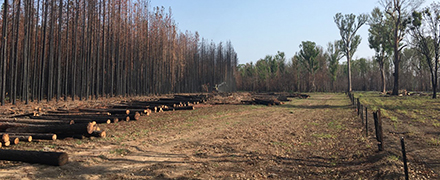Australia’s timber industry is, in the most past, a pretty resilient industry.
Regardless of what gets thrown at it – flood, fire, government interference, protestors – by and large it just knuckles down and gets on with the job at hand.
Especially when it comes to bushfires. The industry not only takes active measures to prevent fires it also takes an active role in fighting those fires when they do occur, and an active role in the clean-up process.
Which is why a joint University of Canberra-Murray Region Forestry Hub report into the socio-economic on the impacts of the recovery period following the Black Summer bushfires of 2019/20 is so important.
The study area included the NSW South West Slopes region around Gundagai/Tumut, down to Mt Buller in Victoria.
The findings of the report reinforced the importance of the softwood plantation industry to the Murray Region Forestry Hub economy, particularly during challenging conditions after the 2019/20 bushfires when many other industries were struggling.
Perhaps unsurprisingly this study found that the industry responded strongly to the resource losses imposed by the 2019/2020 bushfires. Levels of activity increased during the salvage and recovery phase, with increased levels of resource throughput for all sectors. Support from state and federal Governments was designed to assist a level of restructuring to enable the industry to adjust to a ‘new normal’ phase of operations with reduced levels of fibre resource available. The industry has demonstrated resilience and innovation after the bushfires and is facing the future with a degree of optimism.
It found that while harvesting of the timber resource and processing of locally sourced timber in the region will be reduced for some time, and many businesses are continuing to face challenges associated with the bushfire impacts, recruitment of workers and increasing input costs, businesses overall are reporting good business conditions and are confident in their business outlook.
But the Softwoods Working Group’s executive officer Carlie Porteous has cautioned about becoming too blasé about the industry’s future, indicating the fires have had a significant impact on future resource availability, and further support may be required.
She has emphasised the need for preventative measures, reforms, and deeper engagement with government entities to protect the remaining plantation estate and warned of potential industry closures if these measures are not implemented, particularly considering the anticipated pressure on the industry and the region from the financial year 2025 through to the financial year 2033.
Ms Porteous commended the Murray Region Forestry Hub, its committee, and the University of Canberra for their thorough study.
“The industry has not previously examined the socio-economic impacts of a successful post-bushfire recovery process,” she said.
“The industry should be truly congratulated for its efforts to salvage more than 98% of recoverable aged timber during such a difficult time.”
Ms Porteous is of course correct; taking a bit of a “she’ll be right” Australian-style attitude is okay, as long as it’s not taken too far, and for too long.






